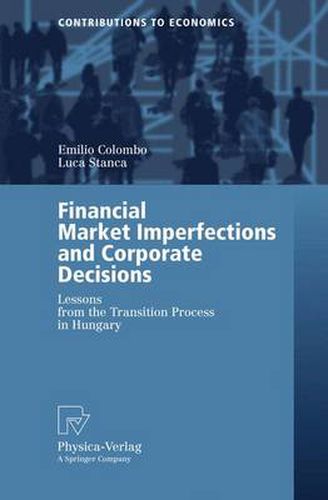Readings Newsletter
Become a Readings Member to make your shopping experience even easier.
Sign in or sign up for free!
You’re not far away from qualifying for FREE standard shipping within Australia
You’ve qualified for FREE standard shipping within Australia
The cart is loading…






This title is printed to order. This book may have been self-published. If so, we cannot guarantee the quality of the content. In the main most books will have gone through the editing process however some may not. We therefore suggest that you be aware of this before ordering this book. If in doubt check either the author or publisher’s details as we are unable to accept any returns unless they are faulty. Please contact us if you have any questions.
We would like to thank Akos Valentinyi and Mark Schaffer for their advice on various stages of this research project. We also would like to thank our col leagues at the Department of Economics of the University of Milan - Bicocca for their advice and support. This book is the result of a long term project financed by various research grants: in particular the Phare-Ace programme (Project P-96-6151-R) and a research grant from the Italian Ministry of Education under the young researchers scheme. Milan, March 2005 Emilio Colombo Luca Stanca Contents Introduction 1 Financial market imperfections and corporate decisions: theory and evidence 7 2. 1 Introduction 7 2. 2 Financial market imperfections, investment and cycles 9 2. 2. 1 The Stiglitz view 9 2. 2. 2 Agency costs and macroeconomic fluctuations 15 2. 2. 3 Assessing the differences 18 2. 2. 4 Further developments 20 2. 2. 5 Empirical evidence 22 2. 3 Financial market imperfections and corporate capital structure 24 2. 3. 1 Asymmetric information and capital structure choice . . 25 2. 3. 2 Agency costs and capital structure choice 30 2. 3. 3 Empirical evidence 32 The transformation of the Hungarian financial system 35 3. 1 Introduction 35 3. 2 Macroeconomic background 36 3. 3 Liberalisation, privatisation and financial development 44 3. 3. 1 Banking and credit 45 3. 3. 2 Equity market 48 3. 3. 3 Foreign direct investment 49 3. 4 Financial sector reform 50 3. 4.
$9.00 standard shipping within Australia
FREE standard shipping within Australia for orders over $100.00
Express & International shipping calculated at checkout
This title is printed to order. This book may have been self-published. If so, we cannot guarantee the quality of the content. In the main most books will have gone through the editing process however some may not. We therefore suggest that you be aware of this before ordering this book. If in doubt check either the author or publisher’s details as we are unable to accept any returns unless they are faulty. Please contact us if you have any questions.
We would like to thank Akos Valentinyi and Mark Schaffer for their advice on various stages of this research project. We also would like to thank our col leagues at the Department of Economics of the University of Milan - Bicocca for their advice and support. This book is the result of a long term project financed by various research grants: in particular the Phare-Ace programme (Project P-96-6151-R) and a research grant from the Italian Ministry of Education under the young researchers scheme. Milan, March 2005 Emilio Colombo Luca Stanca Contents Introduction 1 Financial market imperfections and corporate decisions: theory and evidence 7 2. 1 Introduction 7 2. 2 Financial market imperfections, investment and cycles 9 2. 2. 1 The Stiglitz view 9 2. 2. 2 Agency costs and macroeconomic fluctuations 15 2. 2. 3 Assessing the differences 18 2. 2. 4 Further developments 20 2. 2. 5 Empirical evidence 22 2. 3 Financial market imperfections and corporate capital structure 24 2. 3. 1 Asymmetric information and capital structure choice . . 25 2. 3. 2 Agency costs and capital structure choice 30 2. 3. 3 Empirical evidence 32 The transformation of the Hungarian financial system 35 3. 1 Introduction 35 3. 2 Macroeconomic background 36 3. 3 Liberalisation, privatisation and financial development 44 3. 3. 1 Banking and credit 45 3. 3. 2 Equity market 48 3. 3. 3 Foreign direct investment 49 3. 4 Financial sector reform 50 3. 4.